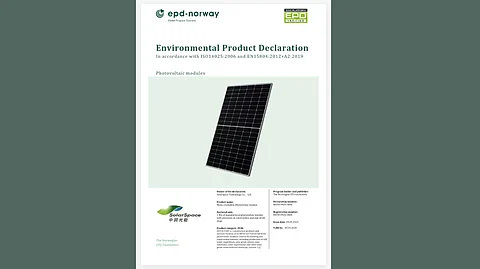China Solar PV News Snippets: SolarSpace Secures EPD Certification For Multiple Modules & More
SolarSpace secures EPD certification for multiple n-type modules
Solar module manufacturer SolarSpace has announced that it has obtained Environmental Product Declaration (EPD) certification for several of its mainstream n-type solar PV modules. The certified models include SS8-72HD-N, SS9-60HD-N, SS9-66HD-N, SSA-48HD-N, SSA-48HDB-N, SSA-54HD-N, and SSA-66HD-N – covering the full range of high-efficiency n-type module formats. The company says that all certified products are manufactured at its facilities in Peixian and Suqian, ensuring consistent production capacity, quality control, and traceability across the supply chain.
SolarSpace is targeting a tier-1 status within the next 2-3 years by leveraging its R&D and cell manufacturing expertise to scale module production (see SolarSpace Aims For Tier-1 Status In Module Market).
AIKO explores wind power project
Leading back-contact cell and module manufacturer AIKO has announced plans to invest approximately RMB 750 million (approx. $104.5 million) in a 112.5 MW wind power project in Linyi County, Dezhou City, Shandong Province. The project is scheduled for completion and grid connection by 2027. According to AIKO, this investment reflects its strategic expansion into renewable energy generation and aims to synergize with its ABC production base in Jinan and regional clean energy clusters in Shandong. Upon completion, AIKO may choose to operate the project independently, sell it, introduce partners, or explore financing tools for asset disposition. The company, however, reaffirmed that n-type ABC technology remains its core development focus.
Speaking of ABC modules, according to recent field test data released by AIKO, its ABC modules were found to deliver up to 46.7% higher cumulative energy yield than TOPCon modules (see China Solar PV News Snippets).
Golden Solar faces major litigation amid pre-reorganization process
Heterojunction (HJT) module manufacturer Golden Solar has provided updates on its pre-restructuring process and major legal proceedings. The company entered pre-reorganization proceedings in July 2024 under the supervision of the Jiuquan Intermediate People’s Court. In February 2025, the court approved the introduction of super-senior debt of up to RMB 300 million (~$41.8 million) at an interest rate not exceeding 8% (see China Solar PV News Snippets). This was aimed at maintaining the operation of core subsidiaries. Currently, 19 potential investors have expressed interest in participating in the restructuring process.
Concurrently, Golden Solar is embroiled in multiple lawsuits. The company and its subsidiaries have been listed as enforcement subjects in court due to Suzhou Golden Solar Technology Co., Ltd.’s failure to comply with financial loan rulings, facing over RMB 82 million (~$11.4 million) in total enforcement claims. The court has ruled to auction off real estate assets, including the company’s primary production base in Wujiang. Golden Solar and its subsidiaries are also involved in 6 undisclosed legal cases, totaling over RMB 6.92 million (~$960,000).
China launches plan for renewable-friendly power system pilot projects
China’s National Energy Administration (NEA) has officially launched the first round of pilot projects for building a new-type power system centered around renewable integration. The pilots will focus on 7 key areas: grid-forming technologies, system-friendly renewable power plants, smart microgrids, computing power and electricity synergy, virtual power plants, large-scale high-ratio renewable power transmission, and next-generation coal power.
For ‘system-friendly renewable power plants,’ the NEA encourages upgrading or building facilities in areas with high renewable curtailment pressure, promoting coordinated control of wind, solar, and storage. Smart microgrid pilots will aim to increase self-consumption of renewable energy and ease pressure on the main grid. Virtual power plant pilots will integrate distributed generation, storage, and flexible loads to improve system responsiveness and renewable energy absorption. Under the computing power and electricity synergy track, the NEA proposes piloting green power aggregation models in Qinghai, Xinjiang, and Heilongjiang, and exploring hybrid operation of solar thermal with wind and PV. Pilots focusing on ‘large-scale high-ratio renewable power transmission’ will target desert-based ‘sand-Gobi-wasteland’ megabases to explore 100% renewable energy transmission solutions.
Eligible pilot projects must commence construction or retrofitting after August 2024, with applications due by June 30, 2025.


